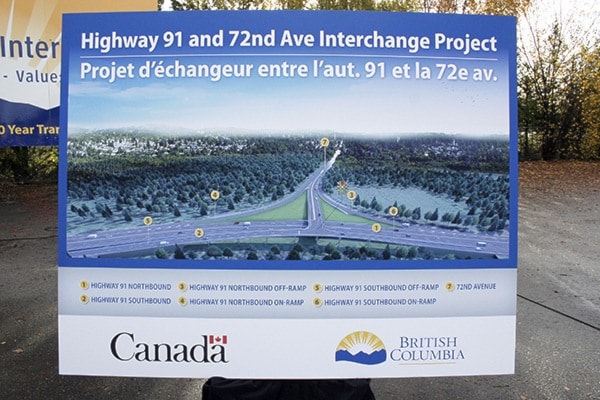Great care is being taken – as land-filling begins for the interchange improvements at 72nd Avenue and Highway 91 – to create the appearance that the surrounding bog is protected: black, woven, perforated plastic having been erected on stakes to keep silt and sand from spreading, though it is the nutrients dissolved in the water running off this fresh, exposed, non-peat soil and right through the perforations that cause non-bog vegetation to proliferate.
A great deal of damage has been, and continues to be, done by the run-off from [previously]-laid mineral fill on either side of the existing highway, which was hurriedly rammed through Burns Bog in preparation for Expo 86 and the associated development of every square inch of the bog [that was] very nearly approved in 1988.
Since then, the trees adjacent to Highway 91 have become much taller, and tree and plant species that were not present prior to the highway now flourish next to it. This impact has never been addressed or compensated for, and it should be.
When the South Fraser Perimeter Road (now named Highway 17) likewise obliterated a wide swath through Burns Bog, the provincial highways ministry compensated for that impact by arranging for the destruction of a fabulous parcel in Burns Bog of extremely, extremely valuable wildlife habitat which it owned and could have rolled into the park. [Instead, it became] a cranberry farm, out of sheer bloody-minded revenge I am sure for them having to re-route their highway away from it because it was deemed too ecologically valuable to alter by Environment Canada.
None of the vast amounts of various types of highly useful and valuable fill within the Burns Bog Ecological Conservancy Area were removed for fill or pre-load for that highway, despite my innumerable pleadings. And I am absolutely certain – though the land-filled old peat plant site is literally a stone’s throw from this project – that none of that fill has been considered for this project either, [be it] out of arrogance, ignorance, disingenuousness, or bureaucratic regulatory paralysis.
Even the most recent development proposal by MK Delta – which would obliterate a half mile square of superb, lush, sphagnum-moss-filled Burns Bog – is tied to improving irrigation for Westham Island rather than to restoring the bog’s hydrology, which could be done by constructing a canal [with] low outer dyke to return tidal and freshet inundation to the edges of the bog and/or by blocking the hundreds of kilometres of ditches sliced through it by would-be-developers in the 1880s and peat extractors in the 1940s.
Nor has the use of any of that fill been mentioned by the developer or [the Corporation of] Delta, though huge piles of sand – callously left by the Ministry of Transportation and Infrastructure in the midst of lush bog within the present ecological conservancy – lie very close to this parcel.
Removal of fill from the Burns Bog Ecological Conservancy Area and the restoration of the bog’s hydrology are vastly more moral and positive infrastructure projects of far greater long-term importance than roads and bridges.
Don DeMille, North Delta
via email
